5.3 Class AB CMOS transconductor
|
5.3 Class AB CMOS transconductor
Ideally, a transconductor linearly converts an input voltage into an output current with both input and output ports presenting infinite impedance. Our transconductor must be implemented in standard digital CMOS and so we must find a solution which has the required high performance while satisfying the voltage headroom constraints imposed by the process.
5.3.1 Cell development
One promising approach which uses the PMOS/NMOS transistor pair proposed by Nauta [11] for mainly high-frequency filters and employed recently by Andreani [12] at lower frequencies is shown in Figure 5.10a. If the PMOS and NMOS transistors P and N have identical parameters (this is an unnecessary constraint but one which simplifies the description), then gmp = gmn = gm and the overall transconductance of this single-ended cell is −G where G = 2 gm. Biasing the input at the mid-rail voltage (Vdda/2) produces equal drain currents J in both P and N and the output current is zero. When the input voltage changes by vin, the drain currents of N and P are unbalanced as given by
![]()
and a linearly related current, iout = Ip − In = −Gvin, flows at the output. This theoretical linearity occurs despite the square law relationships determining the individual currents as shown in normalised form in Figure 5.11. The transconductor is exceptionally efficient because it operates in class AB for peak output currents as high as iout = 4J.
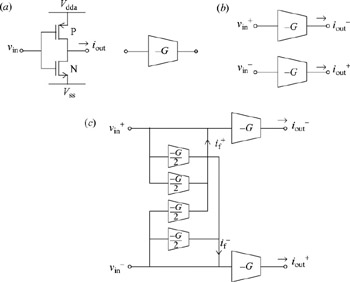
Figure 5.10: Class AB CMOS transconductors: (a) simple single-ended; (b) simple balanced; (c) fully differential
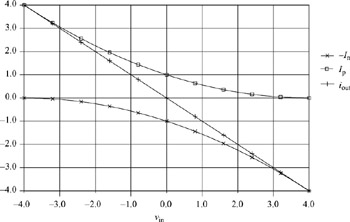
Figure 5.11: Normalised (J = 1, G = 1) behaviour of the class AB transconductor
One feature of this transconductor is that G is influenced by the bias current J which is strongly determined by the supply voltage, Vdda. This feature allows either the value of G or the frequency tuning of the filter to be simply controlled using control circuits like those described later. It also carries a penalty for power supply noise feedthrough. Assuming square-law saturated MOS behaviour, the transconductance is given by
![]()
where k = 0.5 μCoxW/L. If now the value of Vdda is modulated by a signal vd then G is also modulated
![]()
and the output current is given by
![]()
![]()
So, in addition to the wanted output signal, −Gvin, there is an extraneous signal, kvinvd, which results in intermodulation of signals with supply noise. Consequently, great care must be taken when designing the Vdda control circuit so that both Vdd and Vss noise is effectively suppressed.
Balanced transconductors (which are able to convert a balanced input voltage into a balanced output current) are highly desirable. In Gm-C filters, inversion of signals is frequently required and this can be achieved by simply crossing over signal pairs. A simple balanced arrangement may be formed from two of the single-ended transconductor cells as shown in Figure 5.10b, one converting the positive signal voltage and the other converting the negative signal voltage, and achieves a differential transconductance Gm = G/2. Unfortunately, if this simple arrangement is used in feedback networks, such as the gyrator loops occurring in a Gm-C filter, the circuits become unstable.
This can be resolved with a fully differential transconductor such as that shown in Figure 5.10c [11]. It comprises two main single-ended transconductors (−G) and a common-mode feedback network between the input ports. This employs four halfsize single-ended transconductors (−G/2, each using half-width transistors and half the bias current) coupled between the inputs of the main transconductors.
First, consider this transconductor under quiescent conditions, i.e. v+ in = v−in = 0, i.e. both inputs are at Vdda/2 and the output currents are zero. The current in each of the common-mode feedback MOSTs is J/2 and the feedback currents are i+f = i−f = 0
Next, consider the transconductor with purely differential input voltages, i.e. v+in = vdm/2 and v−in = −vdm/2 where vdm is the differential mode input voltage. The feedback currents are again i+f = i−f = 0 because the half-size transconductor pairs generate equal and opposite currents that cancel. The voltages v+in and v−in are applied directly to the main transconductor inputs and a current of −vdm G/2 flows at the outputs.
Finally, consider the transconductor with common-mode input currents, icm. These force the input voltages, v+in and v−in, until i+f = i−f = icm. This occurs when v+in = v−in = icm/G and this causes a common–mode output current i+out = i−out = −icm. So, while the transconductor has not rejected the common-mode input it is nevertheless stable.
One problem with this transconductor arises because of feedthrough from input to output via the gate–drain capacitances. Had these capacitances been reciprocal (i.e. Cgd = Cdg) then the balanced gyrators formed by the −G, + G loops in a Gm-C filter (see Figure 5.12) would have equal feedforward and feedback capacitances which produce no resultant feedthrough. Unfortunately, the capacitances of a MOS transistor in saturation are non-reciprocal [13] as shown in Figure 5.13. As a saturated MOS transistor is ‘pinched-off’ at its drain, voltage disturbances at the drain do not influence the channel charge and so Cgd ≈ 0. On the other hand, voltage disturbances at the gate directly influence the channel charge (to produce a change in the drain current) and so ![]() . In a gyrator loop, the strong feedforward via Cdg in transconductor −G (or + G) is not balanced by an equal feedback via Cgd in transconductor + G (or- G) and this can produce filter responses which peak at high frequency.
. In a gyrator loop, the strong feedforward via Cdg in transconductor −G (or + G) is not balanced by an equal feedback via Cgd in transconductor + G (or- G) and this can produce filter responses which peak at high frequency.
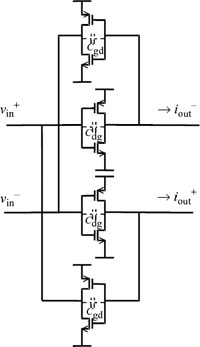
Figure 5.12: Gyrator loop of two transconductors with feedthrough capacitance

Figure 5.13: Capacitances of a MOS transistor in saturation
The solution to this is shown in Figure 5.14. The pMOS capacitors Cp are connected between each input and a source follower connected to each output. Voltage disturbances at the transconductor input produce feedforward via Cp but the capacitive current is routed harmlessly via the source follower to Vss and the transconductor experiences no extra feedforward. However, voltage disturbances at the transconductor outputs do produce feedback via Cp. Clearly, Cp creates only capacitive feedback while the internal transconductors produce only feedforward. If we make ![]() , then the fully differential transconductor has reciprocal feedthrough capacitance. Now when the transconductors are connected as gyrators, the feedforward cancels the feedback and feedthrough is eliminated.
, then the fully differential transconductor has reciprocal feedthrough capacitance. Now when the transconductors are connected as gyrators, the feedforward cancels the feedback and feedthrough is eliminated.
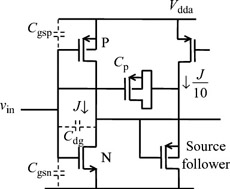
Figure 5.14: Transconductor with capacitive feedthrough equalisation
A further enhancement to the transconductor of Figure 5.10c which improves its common-mode rejection ratio is shown in Figure 5.15. The extra resistor R in the common-mode feedback network is given the value R = 1/G. With purely commonmode input currents, icm, the input voltages, v+in and v−in, adjust until i+f = i−f = icm as before. This occurs when v+in = v−in = icm/G but now icm flows via resistor R to produce an extra voltage drop of −icm/G. Consequently, the transconductor input voltage stays at its quiescent value (Vdda/2) and the common-mode input is rejected. With purely differential signals, i+f = i−f = 0 as before and there is no voltage drop across R.
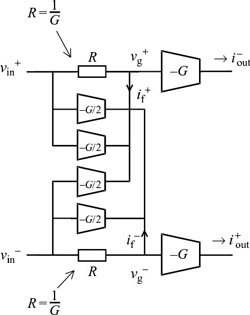
Figure 5.15: Transconductor with improved common-mode rejection
So, in a Gm-C filter, we would use the transconductor with feedthrough equalisation (Figure 5.14) in all gyrator loops but we may use the transconductor with improved common-mode rejection ratio (Figure 5.15) at the filter terminations.
5.3.2 Frequency tuning
One feature of the class AB transconductor cells is their sensitivity to the supply voltage. They are only practicable when operated from a regulated supply and this may be integrated with a coarse automatic frequency tuning scheme as shown in Figure 5.16a. Greater precision would be possible with a phase-locked loop [14] but as the required tuning accuracy was only 6 per cent the simpler arrangement described here was adopted to save power consumption and chip area. The arrangement uses a control loop comprising a skewed ‘diode-connected’ transconductor −G0 which generates a quiescent voltage which is offset from that of the reference transconductor, a parallel arrangement of the reference transconductor −G and switched capacitor C, an integrator comprising −Gint and Cint, a digital inverter and a charge pump Qpump for regulating the Vdda0 supply. In operation, the reference transconductor and switched capacitor supply the integrator with opposite polarity currents, ig and ic, which are integrated and amplified and then used to control the charge pump. With the switched capacitor set to the value G/Fck the currents sum to zero and the loop stabilises with the value of Vdda0 required to achieve the desired time-constant. When the transconductor or capacitor have non-typical values, Vdda0 adjusts to change the transconductance value to restore the time constant to its nominal value. Necessarily, the loop regulates with a ripple on Vdda0 and so the supply voltage Vdda used by the filter is lowpass filtered by Rg and Cg. With the source follower regulating transistors SF0 and SF scaled to produce the same Vgs, the value of Vdda tracks closely that of Vdda0 and the filter's transconductors will closely track the control loop's reference transconductor. The decoupling capacitors Cs0, Cg0, Cs and Cg were all nMOS oxide capacitors connected to minimise their gate voltages. They also serve the purpose of transmitting any substrate interference onto the Vdda rail. With near equal interference on both Vss and Vdda rails very little signal is coupled into the filter.

Figure 5.16: Combined tuning and supply regulator arrangement
The charge pump [15] is shown in Figure 5.16b and operates when its enable input, en, is high and charge is pumped into the load capacitance via the pMOS switch S to produce a voltage at Qout which can rise above the Vdd supply voltage. The resistor RL acts as a pull-up resistor when Qout is low during start-up and as a pull-down resistor when Qout is high and this allows the loop to stabilise satisfactorily.
The tuning loop was designed for a clock frequency of 26 MHz. The transconductor −G0 produces an offset voltage of about 80 mV. The integrator transconductor −Gint was the same as the reference transconductor −G but 20 times larger and so produced the same quiescent input voltage. The capacitors C0 and Cint were each about 20 times larger than the pMOS switched capacitor C, the value of which was adjusted, with typical processing and temperature, until the stabilised value of Vdda had the value needed to tune the filter to its nominal response. The cut-off frequency of the lowpass filter formed by Rg and Cg was made sufficiently low to reduce the ripple on Vdda to less than 0.1 mV.
|
EAN: 2147483647
Pages: 100